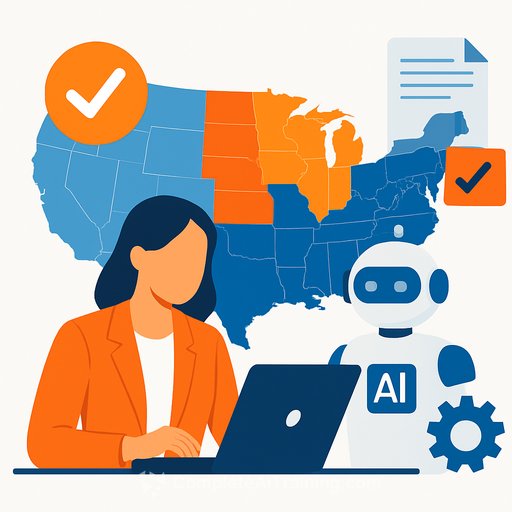AI Readiness in Hong Kong Workplaces 2025: What HR Needs to Prioritise Now
AI use in Hong Kong companies has moved past experiments. According to the HKPC "AI Readiness in Workplace Survey 2025," 88% of employees are already using AI tools, and 92% of organisations plan to formalise AI in workflows. One in four aims to fully implement within a year. For HR, this is a workforce moment-not a tech project.
Key Signals HR Cannot Ignore
- Adoption is mainstream: employees mainly use AI for customer service, data analysis, and marketing.
- Formalisation is underway: 45% already provide official AI platforms for staff.
- Governance gap: 54% lack a complete or ongoing AI governance policy.
- Top barriers: skills shortages, data privacy and security risks, system integration hurdles, change resistance, and cost-especially for SMEs.
What This Means for HR
AI has shifted from "IT's job" to a core skill for every role. HR now owns three things: skills, safety, and adoption speed. That means workforce planning, policy, and culture-delivered in quarters, not years.
The HKPC Playbook: 8 Moves HR Can Drive
HKPC proposes "Three Directions and Eight Actions." Here's how HR turns them into delivery:
- Develop an AI strategy and plan: Tie AI skills to role maps, performance, and workforce plans. Define what "AI-literate" looks like for each job family.
- Top-down leadership and cross-functional squad: Set an exec sponsor, HR-IT-Risk working group, and monthly adoption targets.
- Data governance and compliance: Create acceptable-use rules, vendor assessment checklists, and risk tiers for use cases. Align to local privacy guidance and global norms.
- Company-wide skills training: Run tiered programmes: AI awareness for all, tool fluency by function, and advanced tracks for data/automation leads.
- Integrate with internal systems: Work with IT to enable SSO, data access controls, and change management around workflow tools.
- Embed AI in processes: Start with high-volume, rules-based tasks (support tickets, document summaries, FAQs, reporting).
- "One Enterprise, One AI Coach": Appoint internal AI champions per business unit to run clinics, office hours, and use-case showcases.
- ROI tracking and optimisation: Define 3-5 core metrics (time saved, error rate, CSAT, cycle time, cost-to-serve). Report monthly.
Quick Wins HR Can Launch This Quarter
- Publish a one-page AI acceptable-use policy and tool list. Make it easy to follow.
- Run a 90-minute AI basics session for all staff; follow with role-based labs.
- Pick three pilot processes per function (e.g., candidate screening Q&A, policy chatbots, learning content summaries).
- Stand up an AI Champions network and a shared gallery of approved prompts and playbooks.
- Add AI skills to job descriptions, onboarding, and performance objectives.
Governance and Trust: Non-Negotiable
Employees need clear rules on data use, confidentiality, and human oversight. Build a lightweight risk framework for AI use cases and vendors, including DPIA-style checks. For reference, see guidance from Hong Kong's privacy authority, the PCPD here, and emerging standards like ISO/IEC 42001 here.
What "AI for All" Means for HR
HKPC is pushing adoption with training, technical support, and industry collaboration. Internally, they've delivered 6,000+ training hours, 100+ AI projects, and built "HKPC Picasso" to boost efficiency-proof that structured programmes work.
HKPC Academy has hosted 500+ AI training activities and trained about 22,000 people, with 20+ courses spanning fundamentals to advanced practice. They're partnering with tech leaders and offering free activities to widen access-use this momentum to fast-track your L&D plan.
Where AI Is Already Paying Off
- Smart manufacturing: Visual inspection and predictive maintenance lift capacity and yield.
- Cybersecurity: AI attack-and-defence drills improve readiness.
- Smart city: Data analysis sharpens transport, environment, and public services.
HR Actions for 30/60/90 Days
- Day 30: Publish policy, nominate executive sponsor, set up HR-IT-Risk squad, select pilot use cases, and announce AI Champions.
- Day 60: Deliver awareness training for all, role-based labs for frontline teams, and launch an internal prompt/playbook library.
- Day 90: Embed AI checkpoints in key HR processes (JD updates, hiring rubrics, onboarding, PDPs) and start ROI reporting.
Measuring What Matters
- Productivity: hours saved per process; cycle time reduction.
- Quality: error rates; escalation rate; compliance flags.
- Experience: employee CSAT on AI tools; adoption and active usage.
- Cost: cost-to-serve; training cost per employee vs. savings.
For HR: Practical Learning Paths
If you're building AI fluency across roles, start with structured tracks. Explore role-based paths and current courses here:
Event Spotlight
Alongside the survey release, HKPC Academy hosted "HR + L&D Mixer: Redesigning Work and Employee Experience in the Age of AI," bringing 100 leaders together to tackle job design, talent development, and future skills. The takeaway: treat AI as a people strategy-clear roles, ongoing training, and a culture that rewards smart experimentation.
Bottom Line
AI adoption is here. HR's edge will come from building skills, setting guardrails, and embedding AI into daily work. Move fast, de-risk as you go, and measure outcomes that leaders care about.
Your membership also unlocks:






